The Ultimate Guide To Profitable Business Ideas


By reading this Ultimate Guide you’re already taking the first steps on your journey to a Rich Life. This is only an introduction to the ideas and material you’ll find inside IWT. I started this site in 2004 while I was studying technology and psychology at Stanford. I’ve spent the time since testing and honing my Rich Life systems on thousands of successful students.
At IWT you’ll learn –
Buy all the lattes you want. A $5 coffee is not going to change your financial life. But learning how to automatically invest, how to select the right asset allocation, and how to negotiate a $15,000 raise will. I believe in asking $30,000 questions, not $3 questions.
Your Rich Life is yours. A Rich Life can be picking up your kids every day from school. Or buying a $1,000 cashmere sweater. It can be buying a round of drinks for your friends, or traveling for 8 weeks per year. You decide. Your Rich Life is yours. (Here are some of my Money Rules.)
There’s a limit to how much you can cut, but no limit to how much you can earn. I have readers who earn $50,000/year and ones who earn $750,000/year. We’ve helped tens of thousands of people earn more money by negotiating their salaries, investing, and starting businesses.
Spend extravagantly on the things you love, as long as you cut costs mercilessly on the things you don’t. I don’t believe in cutting back on lattes. In fact, I want you to spend more on the things you love. What if you could double your spending on travel, or eating out, convenience, or charity? I call those Money Dials and I’ll show you how.
The 85% Solution: Getting started is more important than becoming an expert. You don’t need to be perfect to take control of your money. It’s OK to make mistakes. Get 85% of the way there and move on with your life.
Investing should be very boring—and very profitable—over the long term. I get more excited eating tacos than checking my investment returns. You’re in control. This isn’t a Disney movie and nobody’s coming to rescue you. Fortunately, you can take control of your finances and build your Rich Life.
Money is political. You can simultaneously acknowledge personal responsibility and real systemic problems. This is a core part of the I Will Teach You To Be Rich philosophy. Housing is political. Healthcare is political. Voting rights are political. If you’re looking for bland tips on cutting coupons, this site is not for you. I consider it a tragedy to live a smaller life than you have to. So many of us have been raised to believe that money is something to be scared of. We use phrases like “I’m not good with money” or “Money changes people.” Yes, money does change people.
Money allowed me to dream bigger, to be more generous, and to be more adventurous. It can do the same for you. A Rich Life is lived outside the spreadsheet. What’s the point of all this saving and investing if you’re simply going to wait until you’re 80 to live? No thanks. I believe that once you’ve set up your finances, you’ll see that the most important part of a Rich Life is outside the spreadsheet—it involves relationships, new experiences, and giving back. You earned it.
Welcome to your Rich Life journey, I’m excited to see what you do next.
The Best Way to Find a Business Idea — Fast
Over the past 12 years, I’ve helped thousands of students to create their own profitable businesses.
And the #1 obstacle that holds people back?
It sounds crazy. After all, you can go Google “business ideas” right now and get 52,800,000 results. (Wanna be a dog walker?)
But if business ideas are so easy to come by, why is this such a huge barrier for people?
Here’s the rub: You don’t just need any idea.
You need to know:
- If your business idea is profitable (so you don’t waste your time)
- If your idea is something you care about
Anybody can hand you a list of ideas and say, “Run with this. Bye.”
But my approach is different. I’ve developed a system that guarantees you’ll find profitable ideas you enjoy.
Nail this and you’ll be well on your way to having a successful online business. One that gives you the financial freedom to do the things you love. Then you’ll never have to choose between paying bills, saving for the future, or investing in great experiences and products.
Don’t have any ideas? Or have too many ideas?
Relax. I’ve got you covered.
That’s what you’ll get today in this guide. We’ll cover:
- How to start a side business no matter your current situation (working full time, busy family, crazy schedule, student… (we’ve got you covered in Part 2)
- The 6 types of businesses you can start online and how to decide which one is right for you (Part 3)
- How to discover if your business idea will make money BEFORE spending any money (Part 4)
- The 5 things you need to go from $0 to $4,500 online, faster than you ever thought possible (Part 5)
How to Find a Profitable Business Idea in 3 Steps
Step 1 - The first step to finding a profitable business idea: You have permission to come up with ideas that suck.
There are no bad ideas in the beginning stages.
Some of my early business ideas were terrible. But I’ve gone on to create more than 18 successful products.
Today, I’m going to reveal my system for identifying bad ideas — fast — so you can avoid costly mistakes.
And it all starts with this simple realization: You have permission to come up with ideas that suck.
Got it?
Once you’ve internalized this idea, you’re ready to move on to step two.
Step 2 - Ask yourself these 4 questions
It’s easy to sit and create a list of random business ideas. But without the right framework, you can’t tell if these ideas will ever pan out.
That’s why we use this simple exercise to get the ball rolling.
The first part of this exercise is to ask yourself 4 questions.
Question #1: What do I already pay for?
I like to lead with this question because a lot of us can’t even fathom the idea that someone would pay them for something.
But when you think about it, we already pay other people for tons of random stuff.
For example, maybe you pay someone to:
- Clean your apartment
- Change the oil in your car
- Make your dinner
When you start to make your list, you’ll quickly see that you pay other people every day.
That’s why I start with this question. It opens your mind to what’s possible when it comes to business ideas.
So take a second — right now — and think of about 3-5 things that you already pay for. Write them down on a sheet of paper and move on to the next question.
Question #2: What skills do I have?
What are you great at? Write those things down
Remember, there are no bad ideas here. Your list of skills can include anything you want
- Are you good at cooking?
- Do you speak Spanish?
- Are you an Excel wiz?
As you make your list, you’ll start to see what people might pay you for
For example: If you’re great at cooking, maybe someone would pay you to be a personal chef for them.
If you know Spanish, maybe you could tutor someone.
If you’re amazing at Excel, I know plenty of people who would gladly pay you to create some charts for them right now.
I want you to push yourself to come up with a list of at least 10 skills you already have. Write down anything that comes to mind. Don’t filter any of your ideas.
Once you’ve got at least 10, you can move on to the next question.
Question #3: What do my friends say I’m great at?
This is important because it can be very revealing.
Maybe your friends are always saying, “Wow, you give amazing relationship advice. You’re the only person I come to.” Or, “Your apartment is so organized. I wish my place looked like this.” Or, “OMG, you’re always wearing the perfect outfit! I’m so jealous.”
You could turn all three of those things into successful businesses.
Sometimes it’s easy to forget we have these skills because they come naturally.
And if you find yourself thinking, “Ramit, I do not have any skills,” go ask your friends. It might seem a little weird, but I bet they’ll give you a list of at least 3 things you’re amazing at.
Add these ideas to your list. Shoot for at least 3-5 ideas and feel free to ask coworkers and family if you want. You might get different insights that way.
Trust me, you have many skills that have never even occurred to you.
Question #4: What do I do on Saturday morning?
This last question comes from my good friend, Ben Casnocha.
He said, “When you’re trying to find a business idea, think about what you do on a Saturday morning before everyone else is awake.”
- What are you reading? Fashion magazines? Fitness books?
- What are you watching?
- What one thing could you do all day?
Another way to think of this is: If you were locked in a room with your friend, what could you talk about for 3 hours straight?
This is a great way to expose ideas and passions. The things you would have a blast sharing with the world.
By the end of these 4 questions, you’ll have at least 20 ideas written down. If you don’t have 20, go back and ask yourself each question again until you do.
Once you get to 20, you’re ready for step 3.
Step 3 - Use the Demand Matrix to guarantee your success
A lot of people will just say, “Make a list. Have fun!” And leave it there.
But I want to take it one step further. We always test our ideas for profitability. That way we can virtually guarantee they’ll be successful.
And for that, I want to show you a tool we use called the “Demand Matrix.” Here’s what it looks like:

Before we get to that, I want to explain how this chart works.
In the upper right-hand corner of the chart, you’ve got Golden Goose. Ideas that fall under this section make great businesses. That’s because these ideas have the potential to get a lot of customers and command a high price. Think of companies like P90X and Apple’s iPhone — lots of customers, pretty high price. Then, in the bottom right-hand corner, you’ll see Mass Market.
Under Mass Market, you can still get a lot of customers, but you’ll only be able to charge a low price. Think of famous books you might read, like “The 4-Hour Workweek.” There are a lot of customers, but the price-point is pretty low.
Next, in the bottom left-hand corner, you’ve got a Labor of Love. These are business ideas that have few potential customers and can only charge a very low price. Any business idea that falls in this category is doomed to fail — before it even starts. This is your weekend hobby that nobody would pay for (like my dream of teaching people how to eat spicy foods).
Finally, in the upper left-hand corner, you’ve got High End. This is still a great business option because you can charge a high price, but you’ll likely have relatively few customers. Think about companies like Rolls-Royce and Prada.
I mapped out some products for my own business. That way you can see where some of our business ideas fall on the chart:
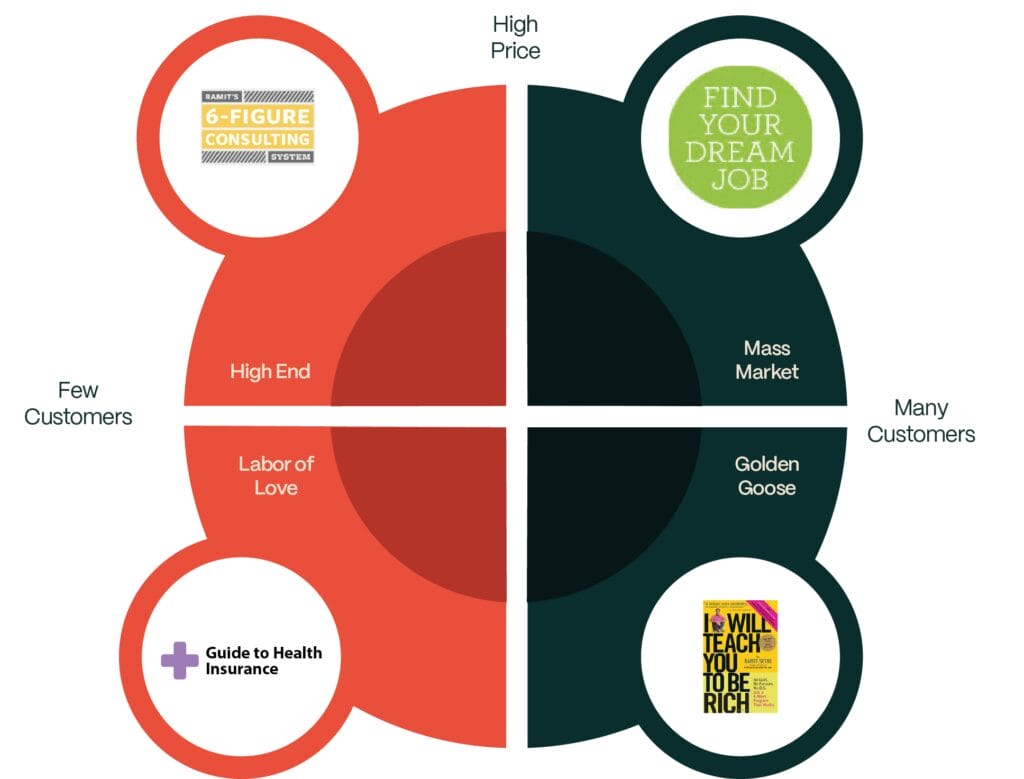
High End
My 6-Figure Consulting System program is an example of this. Since this course helps already successful business owners make more money, it has relatively few customers, but it can command a much higher price. Successful business owners are usually willing to pay a premium price to grow their sales.
Golden Goose
Our Find Your Dream Job course fits here. This is a program where I show people how to find a job they love. Obviously, the market for this is huge because 90+ percent of us have jobs. And because finding a Dream Job is something people really want, we can charge a relatively high price for the program.
Labor of Love
This is where we put all of our business ideas that will probably never see the light of day. Some examples might include an ironing course or a class where I teach people about spicy foods. Yes, those might be things that I love and am great at doing, but there’s not a big market for those. And if I do manage to find a small market, those people would not really pay.
Mass Market
This is where my book, “I Will Teach You to Be Rich,” falls. Books are great mass market products because lots of people buy them, but the price is relatively low.
See how it works? It’s a great way to test your ideas for (1) profitability and (2) demand.
It’s not meant to be super scientific. It’s just a back-of-the-napkin way to find out if an idea has a chance of being profitable.
There are no right or wrong answers.
To test for demand, just ask yourself, “Do a lot of people care about this?” If the answer is yes, then ask yourself, “Are people willing to pay a lot to solve this problem?” to figure out price. Quickly you’ll see where your different ideas fall on the chart. It’s pretty simple, but I want to make sure you go through each step thoroughly. Getting this right up front can save you thousands of hours over the long run.
Take it to the next level with this guide to finding profitable business ideas
By just taking the 3 steps above, you’ve put yourself ahead of 99% of people who think of an idea and spend years of time and tons of money before finding out it will never be profitable.
Continue through the rest of this guide for the exact roadmap I use to develop and ruthlessly test business ideas.
Start a Business While Keeping Your Job: 42 Side Business Ideas
Relying on a 9-5 job can actually be riskier than starting a business and I’ll show you why. We’ll also debunk the myth that you need to go “all in” to start a profitable business. I’ll give you 42 examples of businesses you can start right now even if you’re working full-time, have a family, or go to school. Plus, you’ll meet people with busy lives who were able to turn ideas into profit.
Online Business Ideas That Make Money While You Sleep
Online business is about one thing: Freedom. Freedom to choose projects that fascinate you, make money while you’re on vacation, buy drinks for your friends without worrying about splitting the tab, or travel whenever you want. We’ll cover the 6 types of online business (and which one is best to start) and 3 weird online business ideas that actually make a lot of money
Risk-Free Ways to Test Your Business Idea
Validating your business idea doesn’t have to (and shouldn’t) cost any money. There are a few easy and fast tests you can use to determine instantly if your idea will be profitable. They are deceptively simple, yet most don’t do them. In just minutes, you can move ahead knowing that your business idea is the right one.
Take Your Business Idea From Concept to Profit Fast
You have a profitable idea, now what? I’ll give you the roadmap to get started — whether you’re starting a business on the side, going full time right away, or scaling up with an online business.
Part 2 - Start a Business While Keeping Your Job: 42 Side Business Ideas
We see the stories about people who quit their job, dropped out of school, or invested their entire life savings on a “sink or swim” venture all the time. Which is why it has become a common myth that starting a business is risky.
That’s not how business really works. Successful entrepreneurs limit their risk. Most of them start businesses without spending a lot of money and without quitting their job.
You can do the same thing.
The best part is when your business grows, you have the option of quitting your job if you want to.
In fact, relying on just your full-time salary is actually riskier than starting a business on the side.
Here’s what I mean:
Risk #1: You lose out on money… A lot of it.
Let’s take a minute to measure out the risks of doing nothing in monetary terms. We’ll assume you keep your job, but you also learn how to earn money on the side and learn how to replicate it each month.
If you were to make $500 on the side each month, that’s the equivalent of a $6,000 raise.
And if you made an extra $1,000 each month, you’re basically getting a $12,000 salary bump.
That kind of money could go a long way to helping you pay down student loans, stuff your savings account, or even take a bucket list trip.
But doing nothing guarantees you won’t make an extra cent.
So your biggest fear should not be starting a new business, but continuing to do what you’ve always been doing.
Risk #2: A job is not guaranteed income.
Most people take comfort in thinking that their jobs are safe and secure, even if they’re not the most stimulating or fulfilling.
In exchange for showing up from 9 to 5 every day, you’re basically guaranteed a steady paycheck every month. This kind of reliability lets you plan your finances and your life around a stable foundation.
But let’s look deeper. It doesn’t seem risky to stick to your 9-to-5 job. You know what’s expected of you, you show up every day, you do what your boss says, and you get paid.
But what happens if you get laid off?
Well-paying jobs make us feel like we’re set for life. But that’s not true.
We know layoffs are common, we see people being passed over for promotions all the time, but a lot of us still sit by and do nothing. Why?
Because we’ve been told our whole lives — by our parents, our teachers, our spouses, and even our friends — that a job with benefits is the less risky path. Think about it, most of those people grew up in a time where it was common to stay at the same job for 30 years, retire, and collect a pension. That’s just not the way the world works anymore.
Having a side business is like having layoff insurance.
Look at what happened to a reader, Phil H., who emailed me after he was laid off:
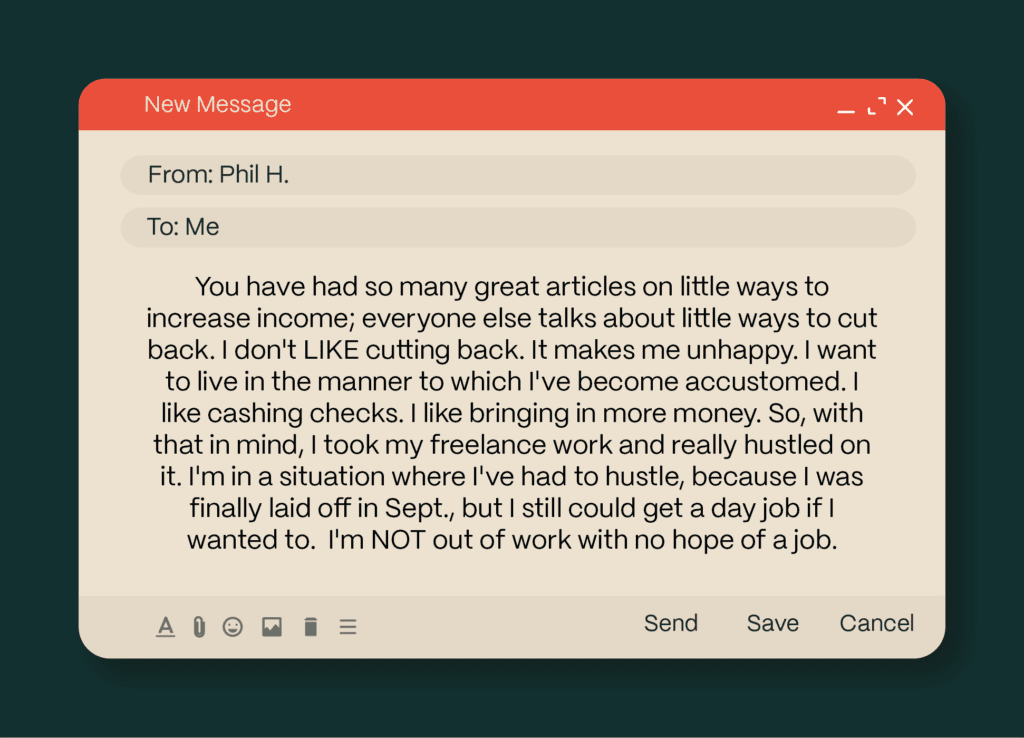
Phil landed on his feet thanks to the fact that he’d already been freelancing for months before he was laid off.
A lot of us have confused the perceived risks and the real risks of our regular 9-to-5 jobs. The perceived risks seem low, but the real risks can be painfully high — and more dramatic than we ever expected.
Thousands of my students have started businesses while working full time. And then, many of them went on to quit their jobs.
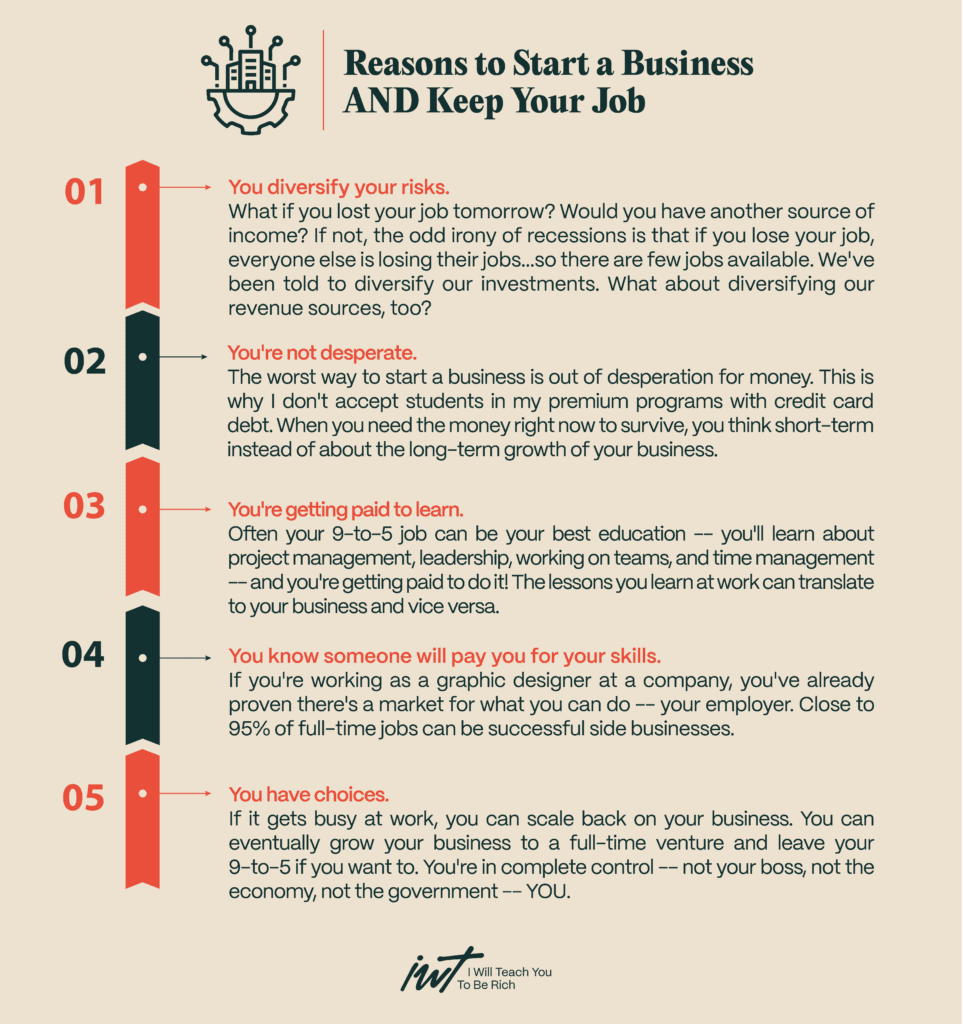
What’s the Best Side Business Idea for You?
No matter what your employment, family status, or location, you can find the right business idea to pursue on the side. Here are 42 examples to get you started.
Side Business Ideas for Beginners
One big barrier to finding a business idea is the myth that you have no skills someone would pay for. That’s not true. People pay for all kinds of services that don’t take any special skills or training.
- Transcription services
- Courier services
- Cooking / personal chef
- Technical writing
- Small business marketing
- Proofreading/editing
- Business writing (business plans, grants, white papers, proposals)
Side Business Ideas for College Students
Even if you’re going to school full-time, you can start a side business doing something you love. You can start many businesses right from your dorm room. In fact, that’s what I did over 12 years ago.
- Video production/editing
- Design (brochures, business cards, logos, newsletters)
- Web design
- Blogging/blog consulting
- Sports / personal training
- Child care
- Search engine optimization (SEO)
Side Business Ideas for Millennials
Many skills that millennials take for granted are really valuable to other generations. My first side business was showing venture capital firms how young people were using social media.
- User interface & user experience (UI/UX)
- Google Analytics
- Programming/web development
- E-commerce consulting
- Tech tutoring (e.g., how to set up and use your tablet)
- Internet marketing consulting
- Fashion/image consulting
Side Business Ideas for Stay-at-Home Moms and Dads
Even if you have a busy schedule, irregular hours, and other responsibilities, there’s a side business idea that you can profit from. One where you’re in control of the hours you work and your location.
- Personal/virtual assistant
- Pet services (grooming, walking, etc.)
- Home maintenance/organizing
- Crafting/personalization services
- Human resources/payroll services
- Project management/productivity consulting
- Copywriting and editing
Side Business Ideas for Working Parents
Working parents often have naturally-developed skills like productivity, planning, and budgeting. These are all skills that can be easily turned into side businesses.
- Photography
- Travel planning
- Event planning/promotion
- Automobile/motorcycle repair
- Tax and financial planning
- Community management/promotion
- Career help (finding work, optimizing resumes, cover letters, interviews)
Side Business Ideas for Teacher
Teaching is the core of a lot of successful side businesses. Full-time teachers have the advantage of predictable schedules and natural people skills.
- Research
- Presentation design (PowerPoint, etc.)
- Tutoring and coaching
- SAT prep
- College application review
- Productivity coaching
- Accounting/bookkeeping
If you’ve read this far, you’d LOVE my New York Times Bestselling book?
You can read the first chapter for free – just tell me where to send it:
Part 3 - Online Business Ideas That Make Money While You Sleep
I created my blog, I Will Teach You to Be Rich, in my Stanford dorm room.
It started as a way to get my lazy friends to stop overspending and getting hit with overdraft fees every month. It was nothing more than a fun side project.
Then, I grew to selling a few products. First, a $4.95 eBook that made some sales — enough to give me some extra spending money each month.
Now, I have over 18 products and systems set up so that my website continues to make money around the clock. I can be on vacation, out to lunch with friends, or even sleeping, and money will be coming into my inbox.
This gives me total freedom.
Yes, I still work. It just doesn’t feel like “work” because I’ve built my business around things I enjoy and am good at. And you can do the same thing.
Which Online Business Should You Start?
Lots of options here. Should you start a drop-shipping company? Software? Etsy? Online courses?
How do you know which is best?
There are 6 main models for an online business
I have systematically tried them ALL, and I’ll tell you the straight truth about which is good and which is bad
As always, learn these rules. When you get more advanced, you can break them!
Your 6 options for starting an online business: Software (including apps), physical products, ads, affiliate marketing, coaching, and online courses.
Some give you huge profit margins, take minimal time, and scale easily. Others require a lot of time, overhead costs, and are difficult to grow.
I’ve tested them all, so let’s walk through them real quick. Then you can decide which model is right for you.
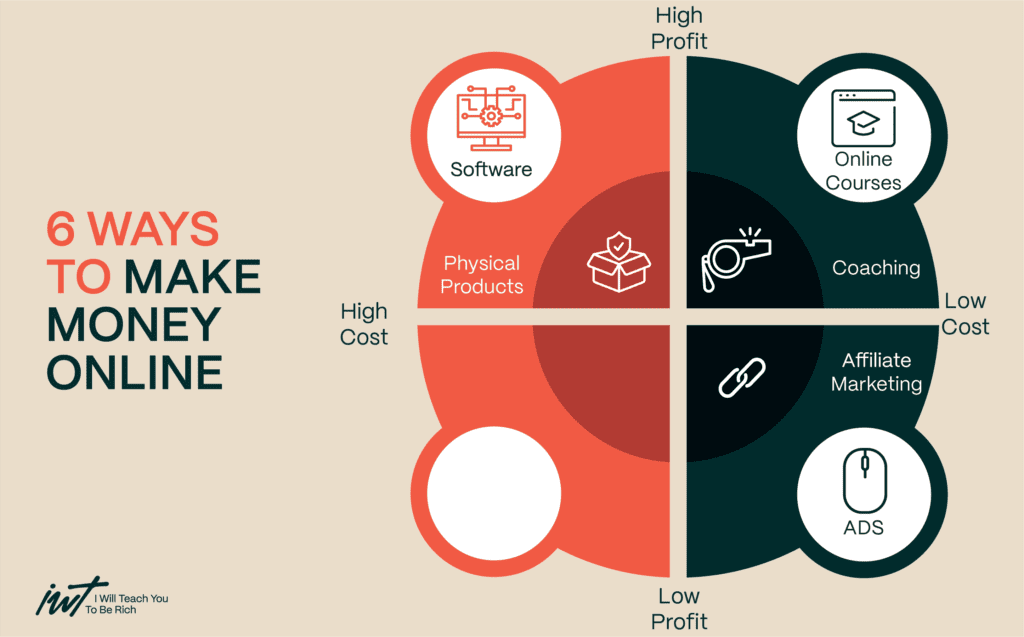
What do you notice about this illustration?
Using this simple framework, you see at a glance if an online business model is attractive or unattractive (most people never do this).
Let me walk you through each one.
Business Model #1 – Advertising
The most common online business model is ads. Almost all of us have seen these. They’re little advertisements — usually Google AdSense — on the sidebars of a website.
Here’s how they work: As you get traffic, some people will click those ads. When they do, you get a few cents, or even a few dollars per click.
I tried this for IWillTeachYouToBeRich.com. But I quickly realized ads don’t make that much money. In fact, what I learned was that you need a huge amount of visitors, like 50 million visitors — or more — per month, to make a good income from ads. That’s a lot of traffic.
Back when I started in 2004, I decided, “If I can’t cover my rent with ads, why bother?” They’re ugly and distracting. Plus, I’ll end up spending more time optimizing the clickthrough rate on the ads than actually writing great content. So after trying that experiment for a little while, I checked the box and said I wasn’t interested in that business model.
Business Model #2 – Software
If you have the skills to create new software, then this can be a tempting option. The media loves to tell us stories about hot new Silicon Valley startups and the founders of tech companies who cashed out for millions after their company went public. So we think starting an online business means doing something similar.
And yes, you could quit your job, seek venture funding, and spend the next few years trying to build the next Instagram.
But let’s face it, for most of us, this isn’t a viable option. We’re not programmers. We can’t code. And we’d rather stab ourselves with an ice pick than try to learn any of that technical stuff (at least I would).
And even if you can code, do you really want to deal with the never-ending challenge of patching and upgrading your app?
Luckily, there are other options out there. You don’t need to create the next Candy Crush to have a successful online business. You don’t even need any technical or computer skills for the other online business models I’m about to show you.
Business Model #3 – Sell Physical Products
I’m wary of this business model because the profit margins are terrifyingly low.
Just to give you an example, we have a notepad that our designers created internally for IWT staff. We would have had to price it at around $50 for a teeny little notepad just to break even if we wanted to sell it. And after we shipped it to people, our profit margin would have disappeared.
I know there’s some money to be made in this space. But I prefer the profit margins offered by online products.
With online products, the costs are lower, the profit margin is higher, and it’s much easier to scale. Physical products just introduce so many variables and costs that I’m not interested in them.
Business Model #4 – Affiliates
Here’s an example of how affiliates work: A blogger will write a review of “My favorite credit cards,” and at the bottom they’ll say, “You can sign up for the card here — NOTE: this is an affiliate link.”
If you click that link and sign up, the credit card company is going to pay that blogger an affiliate commission. Sometimes it’ll be $50 or $75.
Over time, that can add up to a lot of money. And there are affiliate programs for everything — from audiobooks to weight loss products.
For a long time, I avoided affiliates because I didn’t want people to think I was recommending stuff just to make money. I only wanted to recommend the best products.
But eventually I realized that my readers trusted me, they were already going to sign up for the accounts I was recommending anyways. So I decided to try putting an affiliate link in with one of my recommendations.
When I did — virtually overnight — I became ING Direct’s number one affiliate in the world. I was making more than $10,000 a month — just by putting a link on my site.
But I soon learned this wasn’t a great long-term plan. My click through rates tailed off and I ended up having to spend all this time dealing with advertisers.
In the end, I realized it wasn’t worth the time, so I stopped.
Business Model #5 – Online Information Products
Now, my favorite online business model: Selling something you create. Typically, these are information products, like a video course.
You can create a video or written course that sells for $49 fairly quickly. But more expensive, high-end ones take a lot longer. For example, when we built Dream Job, we spent months on research, outlines, testing, creation, and design.
Online courses are low-risk, high-reward, and scale very well. You can use them to reach thousands of people all over the world. It’s become the crux of our business and now we generate over 95% of our revenue through our own products. I can’t recommend it enough.
Take the skills and experience you have and package it into something the world will pay for.
Business Model #6 – Coaching
One of the fastest ways to start earning money from your online business is to offer coaching.
This comes as a surprise to a lot of my students. They join my program looking to create an online information product. But as they build their email list, people message them saying: “Hey, I love what you do. Do you offer coaching?”
There are a few great reasons to take them up on this offer:
- You can charge premium prices for one-on-one work or group masterminds.
- You’re basically getting paid to do customer research. With coaching, you’ll learn their deep fears, desires, and barriers -- information you can use to create an online product that thousands can use.
- It’s a chance to get great testimonials to sell more coaching/other courses.
Coaching is the single best way to start learning business skills.
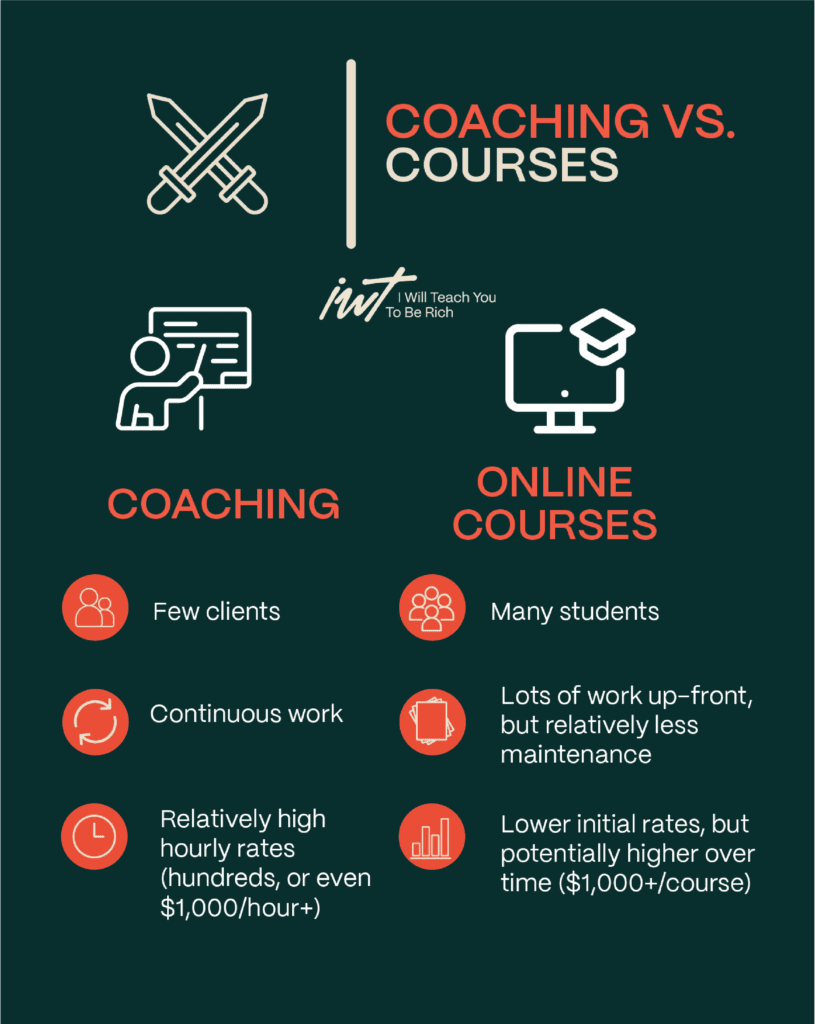
You don’t have to build anything or have a big audience to get started with coaching, and you can earn money quickly, while online courses let you earn revenue automatically and impact a broad audience.
If you can’t choose, do both.
You don’t have to quit your job and raise millions in venture capital funding (which I’ve done as well…and I can tell you I love IWT way more).
Turn Your Weird Skills and Interests Into a Successful Online Business
There are tons of new business ideas surrounding you every day. In fact, you might be surprised when you see how many people will pay for the oddball skills and interests you already have.
I’ll prove it.
Here are 2 unique (yet successful) business ideas that you can use for inspiration to launch an online business of your own.
Unique Online Business Idea #1: Fluent in 3 Months
Go to fluentin3months.com
A brief history of language “hacking”
Benny Lewis spent years struggling to learn a second language, and it was really frustrating for him. Despite taking language courses and trying to learn on his own, nothing seemed to stick.
Then, one day he came up with a strategy that helped him learn Spanish in 6 months. At first he thought it was a fluke, but then he did the same thing, only faster, with Italian, French, German, Portuguese, Esperanto, Mandarin Chinese, Dutch, and Irish.
Now he teaches people how to do the same through his online courses and workshops.
Results: an entirely new world with new opportunities
Even though he’s not a credentialed expert, Benny has become a thought leader in the language learning space. His site and advice have been featured in The New York Times, National Geographic, The 4-Hour Workweek, Business Insider, and Forbes. He was even invited to give a TEDx Talk on language hacking.
Remember, he started as someone who couldn’t even speak a second language. But now, he’s built a platform to make an amazing impact all over the world.
The takeaway: You don’t need any advanced degrees or “credentials” to start an online business. You just need to deliver results.
Think about it. If you’re in the market for a personal trainer, do you walk around saying, “I really need someone who’s NASM and CPT certified?” Of course not!
You want someone who can help you lose those last 10 pounds or get back into your high school jeans. In other words, you want someone with proven results over the credentialed expert.
Unique Online Business Idea #2: Charisma and Confidence Training
Go to felicia-spahr.com
From vague idea to real online business
Felicia always had a passion for communications, sales, client work, and writing, but she didn’t know how to combine these vague passions into a real business.
She started by working with women on their communication skills and writing, but quickly realized she had a knack for coaching. She eventually started teaching those skills online, and it turned out to be a really good way to make an income for her.
Results: earning more money, while working less
Felicia isn’t an “expert” in her field, she simply teaches people social skills and charisma from what she’s learned through years of personal trial and error. But she now earns up to $10,000 a month with her online business, while working only 30 hours a week.
The takeaway: You’re already good at something, you just have to find what it is.
It would have been easy for Felicia to give up because she didn’t know how to turn the things she really enjoyed and the things she was good at into a real business.
But she kept digging to find 1) what she LOVED to do and 2) what people would pay her for. You can do that too with any skills you have.
Unique Online Business Idea #3: I Want to Draw a Cat for You
Go to iwanttodrawacatforyou.com
(Yes, he actually makes money online with this strange and ridiculously specific idea.)
The name pretty much sums up the business: This guy, Steve Gadlin, hand draws pictures of cats (fat, small, wearing hats, tap-dancing, etc.), posts them online, and then sells them to people all over the world. He came up with this idea just for fun. But what started as a hobby quickly turned into a real business with real revenues, almost overnight.
Results: drawing cats = getting paid
He sold more than 18,794 of these simple drawings in 5 years, before closing the site down to start other wacky businesses. Just before he closed up shop, his cat drawings were selling for as much as $29.50 each. Turns out, those “silly” drawings generated some pretty serious revenues with hundreds of thousands of dollars in sales. He also managed to get a $25,000 investment out of billionaire Mark Cuban on “Shark Tank.” All that from taking his vague idea for a fun business and seeing if anyone would pay him for it.
The takeaway: You can use the skills you already have (as weird as they may be) to start a new business.
Here are even more new ideas for your successful online business today.
The world wants you to be vanilla...
…but you don’t have to take the same path as everyone else. How would it look if you designed a Rich Life on your own terms? Take our quiz and find out:
Part 4: Risk-Free Ways to Test Your Business Idea
By now, you’ve identified your skills, strengths, and interests. That’s an important first step. It’s also easy. It just requires a bit of thought and you can knock out the answers in 5 minutes.
Now, it’s time to go out into the real world and test your business idea before investing any time or money.
Take an idea from your ideas on the Demand Matrix in Part 1, and determine:
- Is anyone else offering your service? Now, a lot of people I know will actually get depressed when they notice there’s someone “already doing” their idea. This is the opposite of how I see it. When I see a healthy range of providers for an idea, it tells me there’s a market for that product. It’s good news — not something to shy away from. Since most people are terrible, with some ingenuity you can crush them.
- Is anyone out there looking for your service? Have you ever seen a job posting or help wanted ad for the service you’re thinking of providing? On Craigslist, other jobs sites, or even via word of mouth? These are clear signs of demand for your idea, and that’s also very good news.
If you have no demand, you have no business — end of story.
But if you have demand, it’s time to find your best customers by asking yourself:
Do your potential customers have the ABILITY and WILLINGNESS to pay?
Your market must have the ability and willingness to pay. And some people and groups are particularly bad markets. Here’s how to figure out if your potential market is good or bad:
Notice we’ve spent no money and almost no time on the above exercises. But so few people go through these simple steps to determine if their business idea will make money.
Once you’ve determined there’s a market for your business idea, you can take it to them to test it for free.
An idea in a vacuum is delusion. But when you test it against the market, your idea may slowly reveal itself to be a PROFITABLE IDEA.
Here’s what I want you to do (20 minutes):
- Find 1 person — JUST ONE! — who might be interested in your idea. You can do this via email or in person. If you’re not sure, ask ANYONE remotely close to the idea, even your parents. We’re not aiming for perfection right now, just people.
- “Test” for language using this script: “I’m thinking of starting some kind of website around [YOUR IDEA]. When you talk to your friends about it, what do you say? What’s the biggest problem around [YOUR IDEA]?”
- Write down the exact language they use. Did they really say, “I want a solution that’s easy, fast, and secure?” No, they did not. WRITE DOWN WHAT THEY ACTUALLY SAY. “I hate how these jeans look on me” is a terrific response. “Every day I wake up, I just dread going to work” is another.
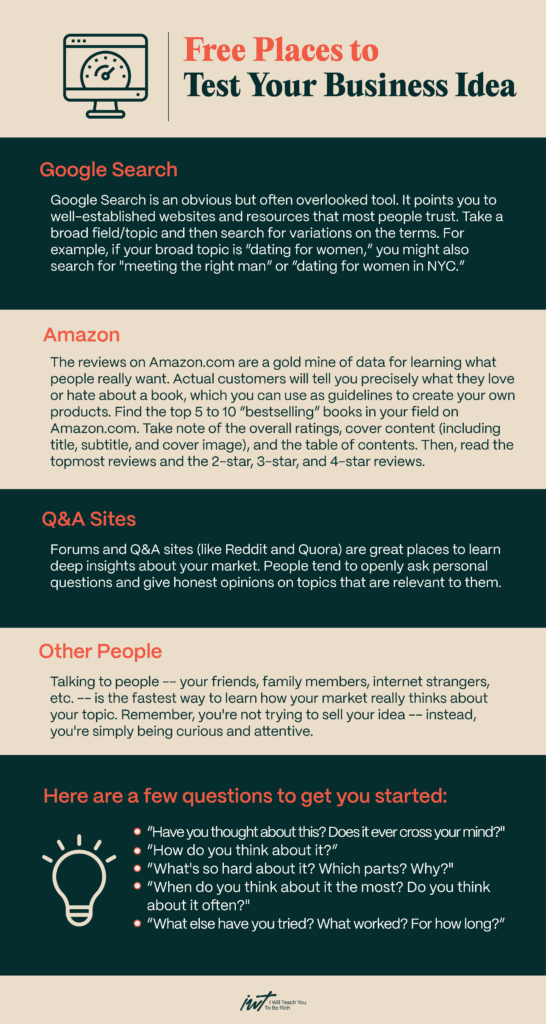
Part 5: Take Your Business Idea From Concept to Profit Fast
Just by reading this guide, you’re ahead of 99% of people who try to start businesses. We’ve covered:
- How to brainstorm dozens of ideas quickly (Part 1)
- The 4 questions that reveal the potential business ideas inside you (Part 1)
- How your current Saturday morning routine may unlock a profitable idea(Part 1)
- Why your 9-to-5 job may be more risky than you think (Part 2)
- 42 side business ideas for busy people (Part 2)
- The valuable (and profitable) skills millennials and moms take for granted (Part 2)
- 6 types of online businesses and which one is right for you (Part 3)
- How real online businesses make money in different ways (Part 3)
- Even more businesses ideas you can use (Part 3)
- A 5-minute test that instantly eliminates bad business ideas (Part 4)
- Free places to validate your ideas (Part 4)
Some of My Students Who Turned Their Business Ideas Into Profits
Karan
The dad who turned his passion for writing into an online business that made $11,000 within 12 weeks.
Darya
The scientist who turned a food blog into a 6-figure business in under a year
Naveen
The business consultant who made $10,000 online before he even had a website
Maria
The habits expert who knew nothing about online business and now makes sales 24/7
Tom
The physics tutor who landed his first 500 subscribers and killed his inner “wantrepreneur”
Earnable is the ONLY online business program proven over 15 years, 50+ industries, and 42,000+ paying customers that covers the ENTIRE process of starting and growing your business. You get access to all the exact strategies, frameworks, hands-on tactics, realworld examples, mindsets, done-for-you templates, word-for-word scripts, and hard-won breakthroughs you need to be successful. Join today and make your Rich Life a reality.